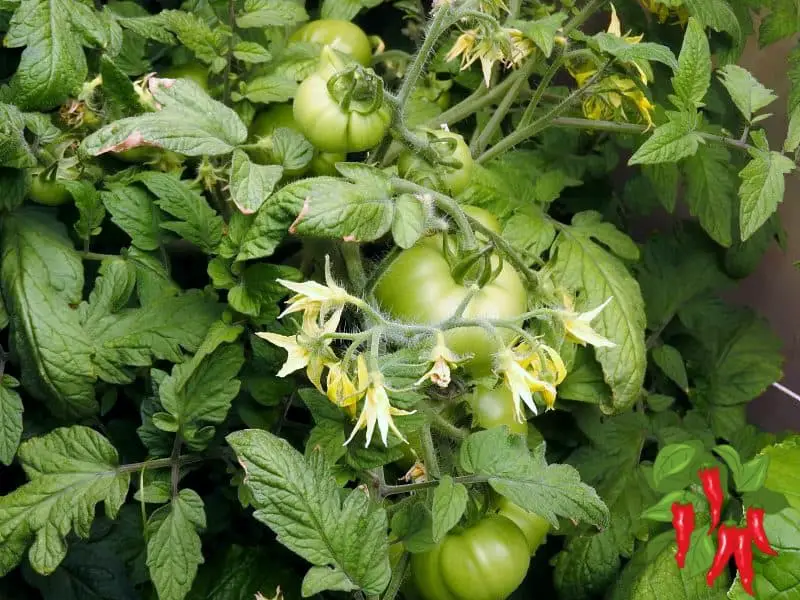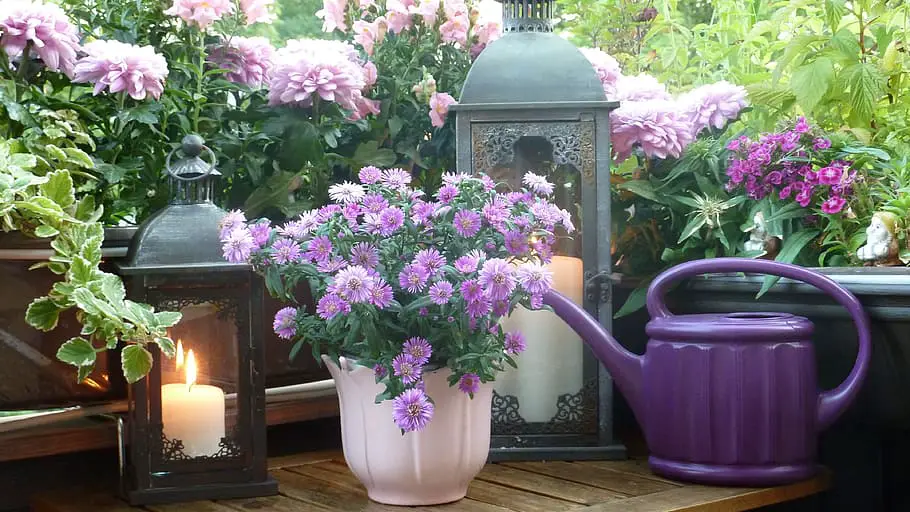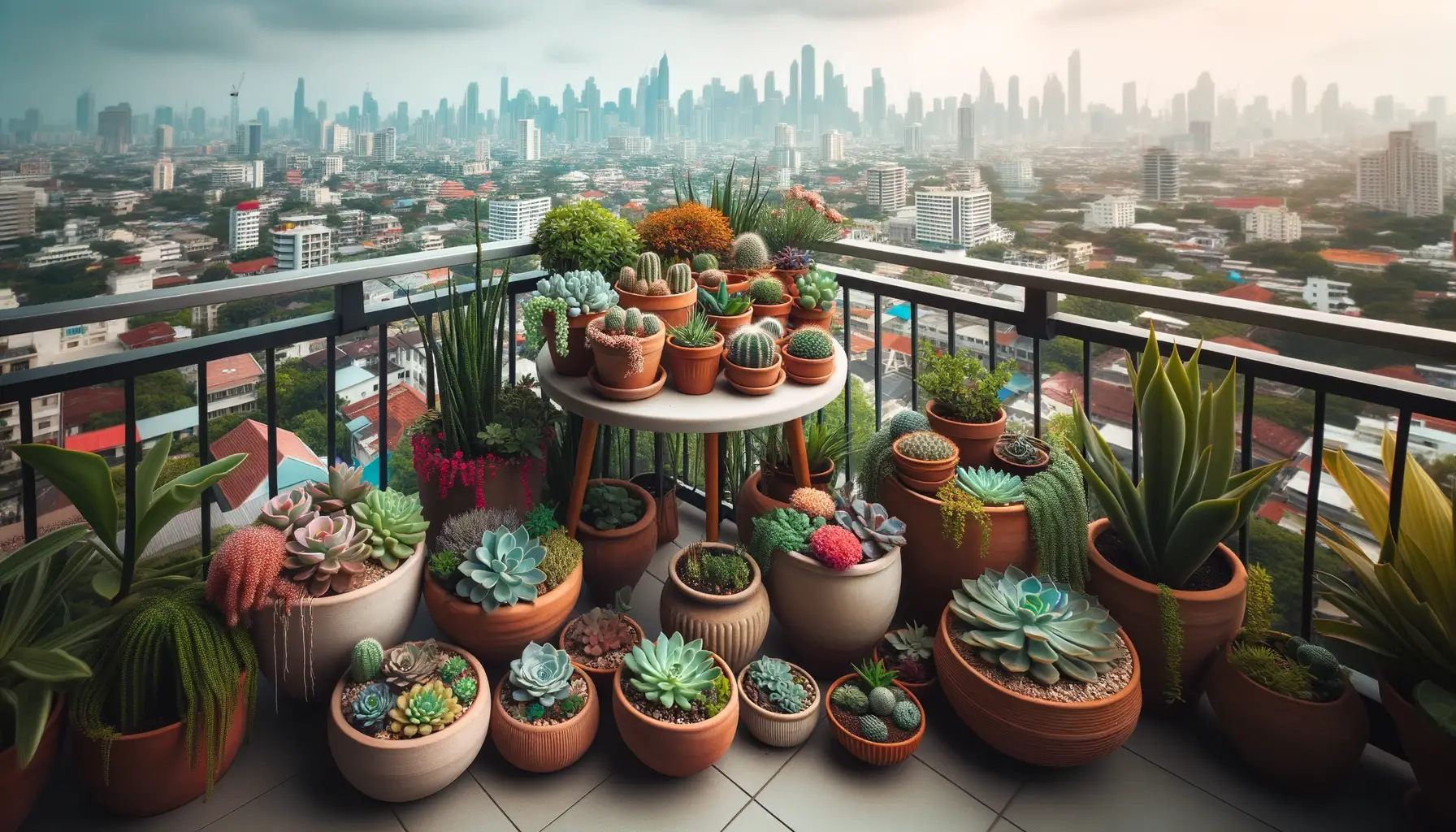
Discover how to choose the right plants for a sunny balcony and transform your outdoor space into a lush, sun-kissed haven!
Plants for Sunny Balconies Key Takeaways:
- To choose the right plants for a sunny balcony, opt for sun-loving, drought-tolerant varieties.
- Consider plants like petunias, marigolds, and succulents, which thrive in direct sunlight and can handle dry conditions.
- Ensure they are suitable for container gardening to maximize your balcony space.
Wondering how to choose the right plants for a sunny balcony? You’re in the right place!
Let’s dive into selecting the perfect sun-loving greens to brighten up your outdoor oasis.
How to Choose the Right Plants for a Sunny Balcony

Creating a sunny balcony garden with plants is a wonderful way to bring greenery, beauty, and nature into your outdoor space.
Whether you have a small or large balcony, making the most of the sunlight can result in a thriving and vibrant garden.
Here are the key points to consider when cultivating a sunny balcony garden:
Choosing the right plants for a sunny balcony:
- Sun-loving plants: Opt for plants that thrive in direct sunlight and can tolerate the heat and intense light.
- Drought-tolerant plants: Select plants that have the ability to withstand dry conditions and require less water.
- Container-friendly plants: Look for plants that are well-suited for container gardening and can adapt to limited space.
Preparing your balcony for planting:
- Assessing sun exposure: Identify the amount of sunlight your balcony receives throughout the day to determine the types of plants that will thrive.
- Checking wind and temperature conditions: Consider the wind patterns and temperature fluctuations on your balcony to choose plants that can withstand such conditions.
- Ensuring proper drainage: Provide adequate drainage for your plants by using well-draining potting soil and adding drainage holes to your containers.
Arranging plants on your sunny balcony:
- Vertical garden techniques: Utilize vertical space by incorporating hanging planters, wall-mounted pots, or trellises to maximize the number of plants you can grow.
- Grouping plants by sun and water requirements: Arrange plants with similar sunlight and water needs together to ensure proper care and maintenance.
- Using containers and hanging baskets: Opt for containers and hanging baskets to save space and create an aesthetically pleasing display of plants.
Watering and caring for plants on a sunny balcony:
- Establishing a watering routine: Develop a regular watering schedule to ensure plants receive adequate moisture, especially during hot and dry periods.
- Fertilizing and pruning: Provide necessary nutrients to your plants through organic fertilizers and trim them regularly to maintain their shape and encourage growth.
- Pest and disease control: Monitor your plants for pests and diseases, and take appropriate measures to prevent or treat any issues that arise.
Benefits of having plants on a sunny balcony:
Having a sunny balcony garden offers numerous benefits such as improving air quality, creating a peaceful and relaxing environment, providing opportunities for stress relief, and allowing for the enjoyment of fresh herbs or homegrown produce.
By avoiding common mistakes and following these guidelines, you can create a thriving and beautiful sunny balcony garden that will bring joy and serenity to your outdoor space.
Creating a Sunny Balcony Garden with Plants

Creating a sunny balcony garden with plants is an enjoyable and rewarding way to incorporate nature into your urban living space.
Here are some tips to help you get started on creating a vibrant and flourishing sunny balcony garden:
Choose sun-loving plants for your balcony garden: Opt for plant varieties that thrive in direct sunlight, such as petunias, marigolds, geraniums, and sunflowers.
These plants will soak up the sun and thrive in your balcony garden.
Consider the size of your containers: When selecting containers for your plants, consider the size of your balcony and the available space.
It’s best to choose larger containers as they provide more room for root growth and improve moisture retention.
Ensure proper drainage: Good drainage is essential for potted plants. Make sure your containers have drainage holes at the bottom, which will allow excess water to escape.
To further enhance drainage, you can add a layer of gravel or pebbles at the bottom of the container.
• Provide adequate water and nutrients: Regular watering is crucial for sunny balcony gardens, especially during hot summer months.
Water your plants thoroughly when the top inch of soil feels dry. Additionally, fertilize your plants with a balanced organic fertilizer to supply them with essential nutrients.
• Protect your garden from extreme temperatures: Take precautions to shield your balcony garden from extreme temperatures. On hot summer days, provide shade using umbrellas, shade cloths, or trellises.
Similarly, during colder nights, cover your plants with a frost cloth or bring them indoors to safeguard them from freezing temperatures.
• Regular maintenance is key: Consistently inspect your plants for pests or diseases and take appropriate action if necessary.
Pruning your plants will encourage growth and remove dead or yellowing leaves. Additionally, remember to remove spent flowers to promote continuous blooming.
• By following these steps, you can effortlessly create a beautiful and flourishing sunny balcony garden with an array of plants, bringing joy and nature into your urban space.
Choosing the Right Plants for a Sunny Balcony
Turn your sunny balcony into a vibrant oasis with the right selection of plants!
Discover the secrets of choosing plants that thrive in the sun, withstand drought, and can be easily accommodated in containers.
From sun-loving blooms to resilient and water-efficient varieties, we’ll explore the best options for creating a lush and colorful balcony retreat.
So, let’s dive into the world of sunny balcony plants and transform your outdoor space into a breathtaking haven of natural beauty!
Sun-Loving Plants
When it comes to creating a sunny balcony garden, choosing the right sun-loving plants is crucial.
Sun-loving plants thrive in direct sunlight and can brighten up your balcony with their vibrant colors and beautiful blooms. Here is a list of sun-loving plants that you can consider for your sunny balcony:
Geraniums:
These popular bedding plants are known for their colorful flowers and ability to tolerate full sun. They come in a variety of colors, including red, pink, and white.
Marigolds:
Sun-loving plants are low-maintenance plants that can withstand hot and dry conditions. They are available in different sizes and colors, and their cheerful blooms can add a touch of warmth to your balcony.
Petunias:
Sun-loving plants are versatile plants that come in various colors and patterns. They thrive in full sun and produce an abundance of flowers throughout the summer.
Zinnias:
Zinnias are easy-to-grow annual flowers that can tolerate heat and drought. With their bright and bold blooms, they will certainly make a statement on your sunny balcony.
Sunflowers:
Sunflowers are iconic summer flowers that love the sun. They can grow tall and bring a touch of sunshine to your balcony with their large, golden blooms.
These plants will not only add beauty to your sunny balcony but also provide a welcoming habitat for butterflies and bees. Enjoy the vibrant colors and the scent of these plants as you relax on your balcony.
One summer, I decided to add some plants to my sunny balcony.
I planted a mix of geraniums, marigolds, and petunias in various pots and hanging baskets.
The balcony quickly turned into a burst of colors, and the flowers attracted bees and butterflies.
It was a joy to see the vibrant blooms every morning as I sipped my coffee on the balcony.
The plants thrived under the sun’s warmth and brought life to the space.
I even received compliments from my neighbors about how beautiful and inviting my balcony looked.
It became my happy place, where I could read a book or simply soak up the sun.
I highly recommend incorporating sun-loving plants into your balcony garden for a delightful and sunny oasis.
Drought-Tolerant Plants
Drought-tolerant plants are an excellent choice for a sunny balcony as they can withstand long periods without water.
Here are some Drought-Tolerant Plants that thrive in sunny conditions:
Succulents:
Succulents like Aloe Vera, Echeveria, and Sedum are known for their ability to store water in their leaves and survive in arid conditions.
Lavender:
This fragrant herb not only adds beauty to your balcony but also has a high tolerance for dry conditions. It thrives in sunny locations.
Agave:
Agave plants have thick, fleshy leaves that store water, making them perfect for sunny, dry balconies. They come in various sizes and shapes.
Rosemary:
Besides being a versatile herb for cooking, rosemary is also a Drought-Tolerant Plant that thrives in sunny and dry conditions.
Oleander:
Oleander is a flowering plant that can tolerate both drought and heat. It produces clusters of colorful flowers, adding a vibrant touch to your balcony.
When choosing Drought-Tolerant Plants for your sunny balcony, keep in mind that while they are more resilient to dry conditions, they still require some water.
It is essential to establish a watering routine to ensure they receive adequate hydration without being overwatered.
To care for Drought-Tolerant Plants on your balcony, periodically assess their watering needs and adjust accordingly.
Fertilize them sparingly, as excess nutrients can lead to excessive growth, making the plant more susceptible to drought stress.
Monitor for any signs of pests or diseases and take appropriate measures to control them.
Having Drought-Tolerant Plants on your sunny balcony not only adds beauty and greenery but also reduces the need for frequent watering and maintenance.
They are a perfect choice for individuals looking for low-maintenance plants that can thrive in hot and dry conditions.
Container-Friendly Plants
Container-friendly plants are a great option for those who want to create a vibrant and beautiful garden on their sunny balcony.
These types of plants are perfect for small spaces and can thrive in containers, making them easy to maintain.
Here are some container-friendly plants that you can consider for your sunny balcony:
1. Petunias: These colorful flowers are perfect for adding a pop of color to your balcony. They come in a variety of shades and can be easily grown in containers.
2. Herbs: Growing herbs in containers is not only convenient but also practical. You can have fresh herbs like basil, mint, and rosemary right at your fingertips for cooking or making refreshing herbal teas. 
3. Succulents: These plants are known for their ability to store water, making them perfect for sunny balconies. Succulents come in various shapes and sizes and require minimal care.
4. Geraniums: Geraniums are low-maintenance plants that produce beautiful flowers in vibrant colors. They can tolerate heat and sunlight, making them ideal for sunny balconies.
5. Ferns: If you prefer a more lush and green look for your balcony, ferns are a great choice. They thrive in containers and can add a touch of elegance with their feathery foliage. 
Adding container plants to your sunny balcony not only enhances the aesthetic appeal but also creates a peaceful and relaxing environment.
These plants can boost mental well-being and help to cultivate a sense of tranquility.
True story:
I once had a sunny balcony with limited space but a strong desire to have a garden. I decided to opt for some easy-to-grow container plants and chose a variety of petunias and herbs.
The balcony transformed into a colorful oasis, and I enjoyed the convenience of having fresh herbs just a few steps away from my kitchen.
It was a joy to come home every day to the vibrant blooms and soothing aroma of the herbs.
Container gardening allowed me to have a beautiful garden in a small space, proving that with the right plants, a sunny balcony can become a cherished sanctuary.
Preparing Your Balcony for Planting
Get your balcony ready for a vibrant and thriving garden! In this section, we’ll dive into the essential steps for preparing your balcony for planting.
From assessing sun exposure to ensuring proper drainage, we’ve got you covered.
Discover the key factors that will help your plants flourish in their new sunny home.
Let’s transform your balcony into a green sanctuary that’s perfect for relaxation and enjoyment.
Assessing Sun Exposure
Assessing sun exposure is a crucial step in the planning process of a sunny balcony garden. Here are some vital factors to consider:
1. Carefully observe the sunlight: Spend quality time on your balcony at different times of the day to observe how the sunlight moves across the space. Make a note of the areas that receive direct sunlight, partial shade, or full shade.
2. Pay attention to the duration of sunlight: Take note of how long each area of your balcony is exposed to sunlight. Certain plants require a specific number of hours of full sun, while others thrive in partial shade or can tolerate full shade.
3. Utilize a sun exposure map: If you have a larger garden or multiple balconies, you can make use of a sun exposure map to determine the areas that receive more sunlight throughout the day. This will assist you in planning the ideal placement for your plants.
4. Employ your hand as a guide: Hold your hand in line with your plants to assess the intensity of sunlight. If your hand casts a faint shadow, it indicates partial shade, while a clear and defined shadow suggests direct sunlight.
5. Consider the surrounding environment: Factors such as nearby buildings, trees, or reflective surfaces can impact the amount of sunlight your balcony receives. Evaluate how these elements may create shadows or block sunlight during specific times of the day.
By undertaking a thorough assessment of sun exposure on your balcony, you can select plants that will thrive in those specific conditions, ultimately creating a thriving and visually stunning garden space.
Pro-tip: In case of limited sunlight on your balcony, opt for shade-loving plants like ferns, begonias, or peace lilies.
Additionally, using reflective surfaces such as white walls or mirrors can help maximize the available sunlight for your plants.
Checking Wind and Temperature Conditions
When it comes to checking wind and temperature conditions on your sunny balcony, it is important to take certain steps to ensure the well-being of your plants.
Here is a list of essential considerations when assessing wind and temperature conditions:
1. Checking wind patterns: Observe the direction and intensity of the wind on your balcony. Determine if it is a consistent strong wind or if it tends to gust. This information will help you select plants that can withstand windy conditions.
2. Creating windbreaks: If wind is a concern, consider installing windbreaks such as trellises, privacy screens, or fabric barriers. These can help protect your plants from excessive wind exposure.
3. Watching for microclimates: Due to the specific conditions of your balcony, unique microclimates may exist. These microclimates can vary in wind intensity, temperature, and sun exposure. Take note of any variations and select plants that are suitable for each microclimate.
4. Monitoring temperature fluctuations: Keep track of temperature changes on your balcony throughout the day. Note any extreme fluctuations or prolonged periods of high or low temperatures. Choose plants that can tolerate these temperature ranges.
5. Providing shade if needed: If your balcony receives intense sunlight and heat, consider providing shade for your plants during the hottest parts of the day. This can be done using umbrellas, shade cloth, or strategically placing plants near walls or furniture that provide shade.
6. Protecting from frost: If your balcony is prone to frost or cold temperatures, take measures to protect your plants. Use frost blankets, bring sensitive plants indoors during frosty nights, or select frost-resistant plants for your balcony garden.
By checking wind and temperature conditions on your sunny balcony and taking appropriate actions, you can create an ideal environment for your plants to thrive.
Remember to regularly monitor these conditions and make adjustments as necessary to ensure the health and well-being of your plants.
Ensuring Proper Drainage
- Ensuring proper drainage is crucial for the health of plants on a sunny balcony.
- Adequate drainage prevents water from pooling in the containers and causing root rot.
- To guarantee proper drainage, choose containers with drainage holes at the bottom.
- If your containers do not have drainage holes, create them using a drill or hammer and nails.
- A layer of gravel or stones at the bottom of the container can help ensure proper drainage.
- Using a light and well-draining potting mix can also contribute to ensuring proper drainage.
- Avoiding overwatering is essential as it can lead to waterlogged soil and hinder drainage.
- Placing the containers on elevated platforms or using pot feet can aid in ensuring water drains more effectively.
- Regularly inspect the drainage holes and clear them of any debris or blockages to ensure proper drainage.
- During heavy rain, consider using saucers or trays to catch excess water and prevent waterlogging, thus ensuring proper drainage.
By ensuring proper drainage, you can create an optimal environment for plants on your sunny balcony, allowing them to thrive and grow healthily.
Arranging Plants on Your Sunny Balcony
When it comes to arranging plants on your sunny balcony, there are a few key techniques and strategies to consider.
In this section, we will explore the art of creating a vertical garden, discover the benefits of grouping plants based on their sun and water requirements, and uncover the secrets of effectively using containers and hanging baskets.
Get ready to transform your balcony into a blooming oasis that maximizes both space and sunlight!
Vertical Garden Techniques

When it comes to creating a vertical garden on your sunny balcony, there are several techniques you can use to maximize your space and incorporate vertical garden techniques to create a stunning display of plants.
- Stacked planters: One popular technique that falls under vertical garden techniques is to stack planters on top of each other, creating a cascading effect. This not only saves space but also adds visual interest to your balcony.

- Hanging planters: Utilizing hanging planters is another great way to incorporate vertical garden techniques and create a vertical garden. You can hang them from the ceiling or railing of your balcony, allowing your plants to hang down and create a beautiful display.

- Wall-mounted planters: By incorporating vertical garden techniques and mounting planters directly onto the walls of your balcony, you can create a fantastic way to utilize vertical space. You can create a pattern or design with the planters, adding a unique touch to your garden.

- Green walls: For a more dramatic and eye-catching effect, consider installing a green wall on your balcony as part of your vertical garden techniques. This involves covering a wall with plants, creating a living work of art.

- Trellises and climbers: A key part of vertical garden techniques is using trellises or supports to grow climbing plants that will cover both vertical and horizontal spaces on your balcony. This adds a lush and vibrant element to your garden.

- Pallet gardens: Another technique you can incorporate into your vertical garden is repurposing wooden pallets as planters. This cost-effective way allows you to create a unique and rustic look by placing plants in the openings between the slats.
Vertical garden techniques offer a creative and space-saving solution for creating a beautiful balcony garden.
Whether you choose to stack planters, hang them, or create a green wall, the possibilities are endless.
So, get started with your vertical garden techniques and transform your sunny balcony into a thriving oasis of greenery.
Vertical gardening has been around for centuries, with examples dating back to ancient civilizations such as the Hanging Gardens of Babylon.
These gardens utilized vertical space to create lush and vibrant landscapes in urban environments.
Today, the use of vertical garden techniques in urban areas where space is limited has made it a popular trend.
It not only allows people to enjoy the benefits of gardening but also adds beauty and greenery to their surroundings.
Grouping Plants by Sun and Water Requirements
When creating a sunny balcony garden, it is important to group plants by their sun and water requirements.
This ensures that each plant thrives and receives the optimal conditions for growth and development.
- Assess sun exposure: Before grouping plants, assess the amount of sunlight your balcony receives throughout the day. Some plants thrive in full sun, while others prefer partial shade. Place plants with similar sunlight needs together to ensure they receive the right amount of light.
- Check water requirements: Different plants have varying water needs. Some plants prefer moist soil, while others are drought-tolerant and require less frequent watering. Group plants that have similar water requirements to simplify your watering routine and prevent over or under-watering.
- Consider plant size: When grouping plants, consider their mature size. Place taller plants in the back or against a wall to avoid shading shorter plants. This allows all plants to receive adequate sunlight for photosynthesis.
- Think about planting containers: Choose containers with proper drainage to prevent waterlogged soil. If grouping plants that have different water requirements, use separate containers for each group to adjust watering frequency accordingly.
- Complementing plant varieties: Select plant varieties that complement each other in terms of sun and water requirements. This creates a harmonious and visually appealing display while ensuring that all plants thrive in their ideal conditions.
- Regular observation: Observe your grouped plants regularly and adjust their placement if necessary. Plants may require different conditions as they grow and develop, so monitoring their progress is important to ensure their well-being.
By grouping plants by their sun and water requirements, you can create a beautiful and thriving sunny balcony garden that enhances the aesthetics of your outdoor space.
Utilizing Containers and Hanging Baskets
Here are some crucial factors to keep in mind when utilizing containers and hanging baskets:
Select the appropriate containers: It is advisable to choose lightweight yet durable containers with drainage holes to allow excess water to drain out.
Plastic, ceramic, or metal containers are all suitable options for container gardening.
• Choose suitable plants: Take into consideration the size and growth habits of the plants you select.
For hanging baskets, opt for trailing or cascading plants like petunias or ivy.
For containers, choose plants that won’t outgrow the space and have sufficient room for a robust root system to develop.
• Ensure proper soil: Utilize a well-draining potting mix that provides adequate nutrients and retains moisture without becoming waterlogged.
Enhance soil fertility by adding compost or organic matter.
• Strategically position containers: Place containers and hanging baskets in areas that receive optimal sunlight for the specific plants you are cultivating.
Consider the sun’s direction throughout the day and adjust the placement accordingly.
• Watering and maintenance: Keep in mind that containers and hanging baskets tend to dry out faster than plants in the ground, so regular watering is essential.
• Check the soil’s moisture level regularly: Water when it feels dry to the touch. Fertilize your plants when necessary and consistently prune or deadhead to encourage healthy growth.
• Consider aesthetics: Have fun experimenting with different combinations of plants, colors, and textures to create a visually appealing display.
Combine plants with varying heights and foliage to add depth and interest to your balcony garden.
By utilizing containers and hanging baskets, you can create a stunning and functional garden space on your sunny balcony.
Selecting the right containers and plants, providing proper care, and considering aesthetics will transform your outdoor area into a vibrant oasis.
Watering and Caring for Plants on a Sunny Balcony
Discover the secrets to keeping your plants thriving on a sunny balcony!
In this section, we’ll dive into the essentials of watering and caring for your sun-loving plants.
From establishing a watering routine to fertilizing and pruning, we’ll equip you with the knowledge you need to ensure your plants get the nourishment they need.
Plus, we’ll share insights on pest and disease control to help you maintain a vibrant, healthy balcony garden. Get ready to unleash the full potential of your sunny sanctuary!
Establishing a Watering Routine
• Establishing a watering routine: Choose the right watering method for your plants on a sunny balcony to establish a regular watering routine.
Options include using a watering can, a hose with a spray nozzle, or a drip irrigation system.
• Water consistently: Consistency is key when establishing a watering routine to ensure that your plants receive the necessary moisture.
This will help maintain the health and vitality of your plants.
• Check soil moisture: Before establishing your watering routine, check the moisture level of the soil by inserting your finger into the soil up to the first knuckle.
If it feels dry, it’s time to water. If it’s still moist, wait a little longer.
• Water deeply: When following your established watering routine, make sure to provide enough water to reach the root zone of your plants.
Watering deeply encourages the roots to grow deeper into the soil, promoting stronger and healthier plants.
• Water in the morning: As part of your watering routine, it’s best to water your plants in the morning.
This allows sufficient time for the leaves to dry before evening, helping prevent fungal diseases and ensuring optimal absorption of water by the plants.
• Adjust watering frequency based on weather conditions: Take into account factors such as temperature, humidity, and rainfall when establishing your watering routine.
During hot and dry periods, you may need to water more frequently.
• Observe plant signs: Pay attention to signs of dehydration, such as wilting or drooping leaves, when following your established watering routine.
Adjust your routine accordingly to provide the necessary hydration to your plants.
• Consider the plant’s water requirements: When establishing your watering routine, take into consideration the specific water needs of each type of plant on your sunny balcony.
Adjust your routine accordingly for each plant.
• Avoid overwatering: While it’s important to provide adequate water, be cautious not to overwater your plants.
Overwatering can lead to root rot and other fungal diseases. Allow the soil to dry out slightly between watering sessions as part of your routine.
• Use mulch: As part of your established watering routine, apply a layer of organic mulch around your plants.
This will help retain soil moisture, reduce evaporation, and prevent weed growth.
Mulching can also regulate soil temperature and improve soil structure.
Fertilizing and Pruning
When it comes to fertilizing and pruning your plants on a sunny balcony, there are a few important steps to follow:
- Choose the right fertilizer: Select a fertilizer that is specifically formulated for your plants’ needs. Look for one that is high in nitrogen to promote leafy growth, such as a 10-10-10 or 20-10-10 ratio fertilizer.
- Fertilize at the right time: Apply fertilizer during the active growing season, which is typically in spring and summer. This will provide your plants with the nutrients they need to thrive.
- Follow the dosage instructions: Be sure to read the label on the fertilizer and follow the recommended dosage instructions. Applying too much fertilizer can burn the roots of your plants.
- Distribute evenly: Spread the fertilizer evenly around the base of the plants, avoiding direct contact with the stems or leaves. This will ensure that the nutrients are distributed throughout the root zone.
- Water after fertilizing: After applying the fertilizer, water your plants thoroughly. This will help to activate the nutrients and prevent any potential burning of the roots.
The Importance of Pruning Your Plants
In addition to fertilizing, pruning is also an important aspect of maintaining the health and appearance of your plants:
- Prune dead or damaged branches: Regularly check your plants for any dead or damaged branches and remove them promptly. This will prevent the spread of disease and encourage new growth.
- Shape and control growth: Pruning can help shape your plants and control their growth. Trim back any overgrown branches to maintain the desired size and shape of your plants.
- Prune after flowering: For flowering plants, prune after they have finished blooming. This will help promote new growth and ensure a more compact and vibrant plant.
- Use the right tools: Use sharp and clean pruning shears or secateurs to make clean cuts. Dull or dirty tools can damage the plants and increase the risk of disease.
- Dispose of pruned material properly: Collect and dispose of the pruned branches and leaves properly to prevent the spread of pests or diseases. You can compost them if they are disease-free.
Fertilizing and pruning are essential tasks to keep your plants healthy and thriving on your sunny balcony.
Follow these steps and your plants will flourish with vibrant foliage and beautiful blooms.
Pest and Disease ControlPest and disease control is a vital aspect of maintaining a healthy and thriving sunny balcony garden.
Pest and Disease Control
Here are some effective strategies to consider for ensuring proper pest and disease control:
1. Regular inspection: Actively monitor your plants for any signs of pests or diseases. Look for common pests such as aphids, mealybugs, or spider mites, as well as indications of fungal or bacterial infections like wilting leaves or unusual discoloration.
2. Natural remedies: Opt for natural pest control methods to avoid using harsh chemicals. For instance, you can utilize neem oil as a deterrent for pests, introduce beneficial insects like ladybugs or lacewings, or create homemade sprays using ingredients like garlic or chili.
3. Proper watering: Provide sufficient water to your plants while avoiding overwatering, as this helps prevent conditions favorable to certain diseases such as root rot. Ensure that your plants have adequate drainage to prevent waterlogging
.4. Pruning and sanitation: Regularly trim away any dead or diseased plant parts, as they can attract pests and harbor diseases. Dispose of the pruned sections properly to prevent re-infestation or the spread of diseases.
5. Crop rotation: If you have multiple plants on your balcony, practice crop rotation by shifting their positions. This approach can help break the life cycle of pests and disrupt the spread of diseases.
6. Quarantine: If you observe any signs of pests or diseases on a particular plant, isolate it from the others. This measure prevents the infestation or infection from spreading to healthy plants.
7. Stay informed: Educate yourself about common pests and diseases that affect the specific plants in your sunny balcony garden. This knowledge will enable you to identify problems early on and take appropriate action.
By implementing these measures for pest and disease control, you can ensure the well-being and longevity of your plants on your sunny balcony.
Benefits of Having Plants on a Sunny Balcony
There are numerous benefits of having plants on a sunny balcony:
- Improved air quality: Having plants on your sunny balcony helps to purify the air by releasing oxygen and absorbing carbon dioxide. This not only creates a healthier environment for you and your family but also contributes to the overall well-being.
- Natural decor: Incorporating plants on your balcony adds beauty and aesthetics, making it a pleasant and inviting space. They enhance the ambiance and make your sunny balcony more enjoyable to spend time in.
- Reduced stress: Research indicates that being surrounded by plants and nature can alleviate stress and anxiety levels. By having plants on your sunny balcony, you can experience a calming effect and enjoy a more relaxed atmosphere.
- Privacy and shade: Depending on the size and type of plants you choose, they can act as natural screens, creating privacy from neighboring balconies or providing shade from direct sunlight. This ensures a more private and comfortable space for your balcony.
- Edible plants: If you have sufficient space and sunlight, you can cultivate herbs, vegetables, or fruits on your sunny balcony. This allows you to have access to fresh and organic produce right at your fingertips, enhancing the convenience and nutritional value for you and your family.
In ancient civilizations, people believed that having plants on their balconies brought good luck and prosperity.
They would cultivate various plants and flowers not only for their beauty but also for their symbolic and spiritual significance.
As time passed, the tradition of having plants on sunny balconies evolved and became a popular practice in many cultures across the world.
Today, people continue to enjoy the benefits of having plants on their sunny balconies, connecting with nature and creating a harmonious living space.
When creating a sunny balcony garden, it is important to avoid common mistakes to ensure the growth and success of your plants.
Common mistakes to avoid on a sunny balcony garden:
- Overwatering: One common mistake to avoid on a sunny balcony garden is overwatering your plants. It is crucial to water your plants effectively based on their specific needs, considering the weather conditions and plant type. Overwatering can lead to root rot and other water-related issues.
- Choosing the wrong plants: Another mistake to avoid is selecting plants that are not well-suited for a sunny balcony garden. It is essential to research and understand the sunlight requirements of the plants you choose. Some plants thrive in full sun exposure, while others prefer partial shade.
- Insufficient drainage: Poor drainage can result in waterlogging and root rot, so it is important to have containers with drainage holes. This allows excess water to escape. Additionally, consider using a well-draining potting mix to promote healthy root growth.
- Not providing enough nutrients: Providing adequate nutrients is crucial for the thriving of your plants. Failing to do so can result in stunted growth and poor plant health. Regularly feed your plants with a quality fertilizer or organic compost, following recommended application rates to avoid over-fertilizing.
- Neglecting pest control: To maintain a healthy sunny balcony garden, it is important to address pests promptly. Regularly inspect your plants for signs of pests and take appropriate measures to control them. This can involve natural remedies or, if necessary, the use of insecticides.
Remember, each plant has unique requirements, so researching and understanding the specific needs of your chosen plants is essential.
By avoiding these common mistakes, you can ensure a vibrant and flourishing sunny balcony garden.
Frequently Asked Questions
Q. What are some hanging plants that do well in a sunny balcony?
A. Some hanging plants that do well in a sunny balcony include pothos, spider plants, and golden bamboo.
Q. Can I grow plants in window boxes on my sunny balcony?
A. Yes, window boxes are a great option for growing plants on a sunny balcony. You can plant sun-loving herbs or flowers in window boxes.
Q. How should I introduce plants to bright outdoor lighting on my sunny balcony?
A. It is advised to introduce plants to bright outdoor lighting slowly to prevent sunburn. Gradually increase the amount of sunlight they receive each day.
Q. What are the best plants for a shady zone on my balcony?
A. Plants like snake plants, spider plants, and peace lilies can thrive in a shady balcony space.
Q. What are some tips for moving indoor plants outdoors to a sunny balcony?
A. When moving indoor plants outdoors, start by placing them in a shaded area and gradually expose them to more sunlight. Avoid direct sun and excessive rain. Provide adequate watering and monitor for any signs of stress or damage.
Q. What are some plants suitable for a sunny balcony with dry and warm conditions?
A. Succulents and cacti are great choices for a sunny balcony with dry and warm conditions. These plants are drought-tolerant and can thrive in such environments.
















